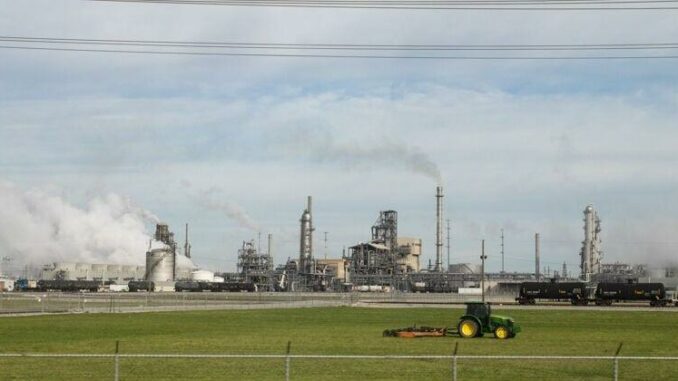
DONALDSONVILLE, La. – A complex of industrial towers rises from the flat landscape at the edge of a highway, its stacks and pipes snaking around each other. Workers in neon yellow vests and protective helmets navigate the maze in pickups. Manufactured clouds float above the nearby Mississippi River, where barges and ships move goods up- and downstream.
This is CF Industries’ Donaldsonville Complex, the world’s largest ammonia production facility. The 1,400-acre nitrogen fertilizer plant is part of a sprawling global industry that’s responsible for a significant chunk of greenhouse gas emissions worldwide.
According to a 2022 study in Scientific Reports, the synthetic nitrogen fertilizer supply chain is responsible for 2.1% of global heat-trapping gas emissions – greater than the emissions from all aviation. The Donaldsonville plant alone is the largest source of industrial greenhouse gas emissions in Louisiana.
But the emissions footprint of nitrogen fertilizers doesn’t stop at the factory; planet-warming gases arise throughout the fertilizer’s life cycle. According to the study, only about 41% of emissions come from the process of making and shipping fertilizer from places like Donaldsonville. The majority are generated from farm fields after the fertilizer is spread.
The root of the problem: Some farmers are applying more fertilizer than what is needed for optimal plant growth. “The plants are not taking the extra nitrogen,” said Alicia Ledo, a co-author of the Scientific Reports study. “It’s just going up into the atmosphere, which is a waste.”
The journey of nitrogen fertilizer – and its release of potent heat-trapping gases – is an extensive one, and it affects the climate along the way.
At the factory
The discovery of a process to make synthetic fertilizer in the early 20th Century revolutionized agriculture, enabling great leaps in productivity.
The Haber-Bosch process, still in use today, takes nitrogen from the air and combines it with hydrogen from fossil fuel – usually natural gas, also called methane – to produce ammonia. The process emits two main greenhouse gases: methane and carbon dioxide.
The manufacturing process also releases methane, a gas more than 25 times as potent as carbon dioxide that lasts a shorter time in the atmosphere. A study by Cornell University and the Environmental Defense Fund found methane emissions from six representative fertilizer ammonia plants were 100 times higher than the fertilizer industry’s self-reported estimates.
In the field
After production, fertilizer is shipped out via pipelines, barges, ships, trains and trucks. Transportation accounts for 2.6% of fertilizer’s total emissions, according to the study.
Then it’s on to distributors and ultimately, farmers and their fields. Every year, 6 million tons of nitrogen fertilizer are applied to corn across the U.S., especially in the Midwestern Corn Belt.
In the United States, an estimated 72 million tons of carbon dioxide-equivalent emissions come from the nitrogen applied to farmland. This is all due to the nitrogen cycle, where nitrogen and its compounds are made accessible to plants and other living organisms.
The air we breathe is full of nitrogen, but plants need to convert the gas into a usable form. “Bacteria and other organisms help break it down. Crops like legumes, beans and peas are good at fixing nitrogen, but others, such as corn, tomatoes and melons, often cannot meet their nitrogen needs without extra help.

In Florida’s “Bone Valley,” a hotspot for fertilizer production, a pipeline transports liquid ammonia. (Photo by Lauren Whiddon/WUFT)
Fertilizer amplifies the soil’s natural microbial activities to produce more nitrous oxide, a gas 265 times more potent than carbon dioxide that consumes the planet’s protective ozone layer.
Nitrous oxide emissions are produced “to some extent anytime nitrogen is available in the soil,” said Rod Venterea, a federal soil scientist and adjunct professor at the University of Minnesota. “Now, we have the opportunity to add larger amounts of nitrogen to the soil, and that’s stimulating natural processes, as well as creating hot spots of production well beyond what is produced naturally.”
In streams and rivers
Extra fertilizer also can wash off fields and into groundwater and rivers, sending nitrogen, phosphorus and other nutrients downstream.
High levels of nutrients causes algae to grow in bodies of water, in turn creating more emissions of nitrous oxide, carbon dioxide and methane. This process is called eutrophication.
A 2018 study estimated that eutrophication in lakes and impoundments accounts for 20% of global carbon dioxide emissions from fossil fuels. Methane emissions from eutrophication in lakes are expected to increase 30-90% over the next century due to climate change and population growth.
Jessica D’Ambrosio, the Ohio agriculture project director for the Nature Conservancy, works to reduce nutrient pollution into Lake Erie, which has suffered from extensive algae blooms caused in part by fertilizer runoff. Roughly 80% of the land draining into the lake is agricultural.
“If you reduce the amount of nitrogen fertilizer you use, you’re helping reduce algal blooms and greenhouse gas emissions,” D’Ambrosio said. “If your soils are healthy and they’re holding on to nutrients, it’s doing both things for you and your watershed.”
Lowering fertilizer’s emissions
Given fertilizer’s huge greenhouse gas footprint, producers and users are facing increasing pressure to change.
André Cabrera Serrenho, an assistant professor of engineering at the University of Cambridge, co-authored a recent study in Nature Food that found the emissions from fertilizers could be reduced by 80% by 2050 using currently available technologies.
About a third of emissions, the study found, could be cut by decarbonizing the production process. Renewable energy can be used for heating and creating the hydrogen used to make ammonia. This process is sometimes called “green hydrogen” production. Another option is using so-called “blue ammonia,” which still relies on fossil fuels but captures and stores the resulting carbon dioxide, sometimes injecting it underground to help recover oil and gas.
The fertilizer industry has latched onto both technologies. CF Industries’ Donaldsonville plant began construction on an electrolysis system at the end of 2021 that is expected to produce 20,000 tons of green ammonia a year, or a quarter of 1% of its total production. The company also has partnered with ExxonMobil on a carbon-capture project for Donaldsonville and is evaluating a nearby site for a new $2 billion, export-oriented blue ammonia production facility.
The Mosaic Co., another leading fertilizer company, is working toward net-zero emissions goals. Mosaic is not pursuing green ammonia at this time due to the high cost and is exploring carbon capture, spokeswoman Natali Archibee said.
Carbon capture has met with pushback from industry-weary neighbors and from critics who say it only maintains reliance on fossil fuels.

A 2022 report by the Center for International Environmental Law called carbon capture technology a “false solution” that attempts to launder the fertilizer industry’s emissions through “greenwashed” products. “The energy required to produce blue hydrogen makes it as bad, if not worse, than just burning gas directly,” said Carroll Muffett, president and CEO of CIEL.
Moreover, greener production is only part of the solution, as two-thirds of emissions come after it’s applied. Nitrous oxide emissions from bacteria in the soil can be reduced by adding chemicals called nitrification inhibitors, Serrenho’s study found. Switching to lower-emission fertilizers also would help.
However, the most important change is to cut the amount of fertilizer used. Less than half of fertilizer applied globally is taken up by plants. Farmers could use far less without reducing yield. “Just by doing that we can save half of emissions associated with fertilizers and other environmental impacts,” Serrenho said.
The CIEL report called for a transition away from industrial agricultural models and synthetic fertilizer and toward more regenerative models that would make food more sustainable to produce while protecting biodiversity.
“Beginning that transition away from fossil fertilizers to more sustainable food solutions is not only a critical part of responding to the climate crisis, but also putting us back within our planetary boundaries that keep the Earth safe to live on,” Muffett said.

Leave a Reply